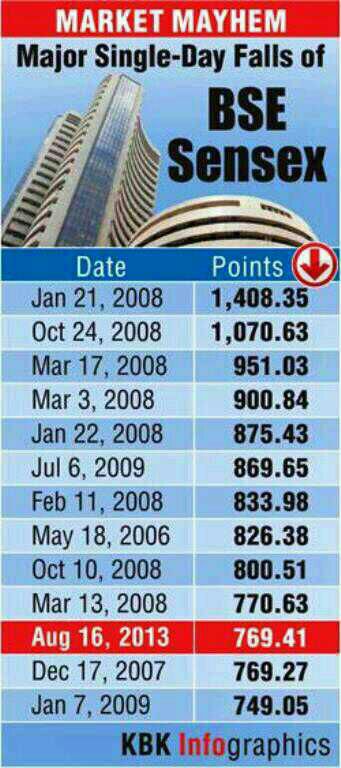Tags
black firday, BSE SENSEX, business, CAD, Dow, economy, Emerging markets, FII, Finance, India, Indian rupee, Nifty, Quantitative Easing, RBI, United States, US Dollar
769 points. That is how much Sensex fell yesterday. With a fall of 3.97% BSE Sensex witnessed highest single day fall since July 2009 amid heavy selling by FIIs (Foreign Institutional Investors) on the fears of QE tapering down and and a rumor of RBI imposing capital controls and stopping FIIs from taking their money back. All 13 sectoral indices closed in red with consumer durables, reality, metal, banking and capital goods leading the pack
On comparing yesterday’s fall with the biggest fall since the last 10 years, yesterday’s fall does not even come under the top 5 list on absolute basis.
The business standard has published an article regarding the first quarter results. In the first quarter of FY 13-14, of the 1961 companies (excluding banking, oil & gas psu) which have declared results up till 13th August, showed that the net sales increased marginally by 3.6% on YoY basis. This has been the lowest sales growth in the last 13 quarters. The net profits have dipped 5.4% YoY as a direct result of rise in interest cost by 19%. More and more sectors are facing the heat and this time around it is not limited to capital goods, construction and infrastructure sector but all sectors.
The big question is, when will the recovery start. To answer this question, we have to understand whether India’s problems are cyclical or structural in nature. Before we dwell into it, let us note down the various problems :-
- Lack of economic reforms and timely implementation.
- Poor governance and bureaucratic issues.
- Excessive corruption.
- Poor infrastructure.
- Poor tax to GDP ratio.
- High inflation and structurally weak currency.
All these problems are structural in nature and they have multiplied the economic problems many fold. This all points to the fact that India’s problem are not because of global slowdown alone, but a major reason are these domestic problems. Infact yesterday’s market fall is a testament of the very same fact. Let me prove it to you.
The US had fewer initial jobless benefits claims than in any week since the first week of October 2007. The Eurozone economy grew for the first time in seven quarters. Portugal had an unexpectedly strong second quarter, emerging from its two and a half year recession. Greece posted a surplus. Japan’s economy grew by 2.6% in the second quarter, after a 3.8% expansion in the first. This all points to QE tapering down. However, only Indian markets fell by this big margin. Rest all Emerging Markets and EU markets were more or less stable. And the very reason for this is Domestic Mis-governance.
High food and fuel prices have kept inflation high and the RBI is forced to keep the interest rates high sacrificing the growth and development. Many experts believe that it will take at least two to three years to solve the structural economic problems and one should not expect the easing of interest rates in current financial year.
High interest rates and poor corporate earnings will keep the investment activity at the lowest level and will delay the economic recovery. In short, India has entered a vicious cycle of slow growth and drying investment.
RBI has announced quantitative restrictions on overseas investment by Indian companies. The world looks at these steps as capital control measures even though the government insists that these are just temporary measures to defend the currency. Many corporates are disappointed, in the sense that they have stopped investment in India due to all the above problems and have started to invest overseas and the recent measures are real hurdles for them. Until the government comes out with structural solutions, it will not be able to lure the investments that are taking place overseas by the Indian Corporates. Unless this is happens, the GDP growth and currency problem cannot be solved.
To help bridge the current account deficit, the government has raised import duty on gold with little impact on gold consumption. In fact in the June quarter, India’s gold consumption rose to 310 tones which is the highest ever seen in last 10 years. India is the world’s largest buyer of gold and unless and until this appetite for gold is reduced we can not expect drastic reduction in current account deficit.
The Dow fell by more than 225 points on Thursday and investors also sold bonds driving the 10 years yield to its highest level of 2.84% in more than 2 years creating more problems for India
We are at such a cross roads where by to increase the value of Rupee we have to raise the interest rates and sacrifice the growth. Our external borrowings is increasing day by day and unless and until we can boost our export in a sizable manner and attract the foreign direct investment rather than borrowings in USD, we cannot come out of this situation. Have wait and watch approach for investment in equity. Any fall below 5470-5480 level can trigger another sell off.
Related articles
- India’s Rupee Slides to a Record Low (businessweek.com)
- It was Black Friday for markets (thehindu.com)
- Capital control fears ravage Dalal Street (dnaindia.com)
- India”s gold consumption at 310 tonnes in Q2,highest in 10 yrs (news.in.msn.com)
- Sensex, rupee plunge amid capital control fears; gold surges (dnaindia.com)
- A taste of things to come for stocks as India’s sensex index craps out? (forexlive.com)

